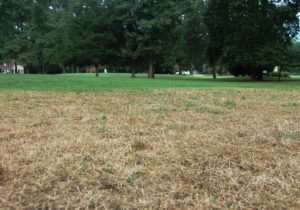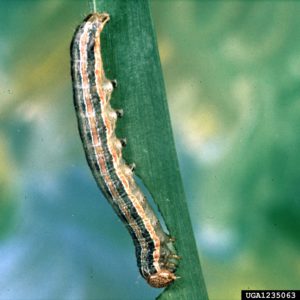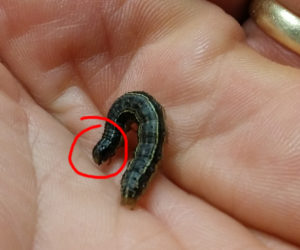Fall Army Worms
go.ncsu.edu/readext?552554
en Español / em Português
El inglés es el idioma de control de esta página. En la medida en que haya algún conflicto entre la traducción al inglés y la traducción, el inglés prevalece.
Al hacer clic en el enlace de traducción se activa un servicio de traducción gratuito para convertir la página al español. Al igual que con cualquier traducción por Internet, la conversión no es sensible al contexto y puede que no traduzca el texto en su significado original. NC State Extension no garantiza la exactitud del texto traducido. Por favor, tenga en cuenta que algunas aplicaciones y/o servicios pueden no funcionar como se espera cuando se traducen.
Português
Inglês é o idioma de controle desta página. Na medida que haja algum conflito entre o texto original em Inglês e a tradução, o Inglês prevalece.
Ao clicar no link de tradução, um serviço gratuito de tradução será ativado para converter a página para o Português. Como em qualquer tradução pela internet, a conversão não é sensivel ao contexto e pode não ocorrer a tradução para o significado orginal. O serviço de Extensão da Carolina do Norte (NC State Extension) não garante a exatidão do texto traduzido. Por favor, observe que algumas funções ou serviços podem não funcionar como esperado após a tradução.
English
English is the controlling language of this page. To the extent there is any conflict between the English text and the translation, English controls.
Clicking on the translation link activates a free translation service to convert the page to Spanish. As with any Internet translation, the conversion is not context-sensitive and may not translate the text to its original meaning. NC State Extension does not guarantee the accuracy of the translated text. Please note that some applications and/or services may not function as expected when translated.
Collapse ▲If large areas of your lawn have suddenly disappeared or turned brown, fall armyworms may be the cause. The fall armyworm is technically a cutworm, but when the larvae (worms) are numerous, they feed in an “armyworm” habit, consuming nearly all vegetation in their path.
Fall armyworms can feed on over 80 plant species, but they prefer warm season grasses such as corn, sorghum, Bermudagrass, and crabgrass.

Damage to tall fescue caused by fall armyworm feeding. (Charlotte Glenn, NC State Extension Master Gardener Volunteer Coordinator).
Tall fescue is typically not their first choice, but this year, I’ve seen a few tall fescue lawns completely devoured by this insect.
Established lawns may recover from the feeding damage. However, if the damage coincides with hot, dry conditions, the yard will not recover and will need to be reseeded.
Where Do Armyworms Come From?
The adult fall armyworm is a small moth with gray and brown wings. These insects do not overwinter in North Carolina. The adult moths migrate northward from Florida and the Gulf coast each summer. The female moth lays around 1,000 eggs in masses of 50 or more. The eggs are typically laid on vertical structures such as houses, shrubs, trees, fences, or mailboxes. The small caterpillars hatch from their eggs and set out in search of food.
At first, feeding is not noticeable because the worms are very small.

A fall armyworm feeding on a blade of grass (Clemson University – USDA Cooperative Extension Slide Series, Bugwood.org)
After a couple of weeks, the caterpillars are larger and feed voraciously as they march across turf areas, eating all above ground green leaf tissue and leaving behind large areas of thatch and brown turf. After feeding for 2 to 3 weeks, the caterpillars burrow into the top inch of the soil to pupate. Within 2 weeks, a new population of moths emerge to start the cycle over again. Fall armyworm can be a problem until a killing frost in October.
Treatment of Fall Armyworms
Often by the time fall armyworm damage is noticed, the caterpillars have finished feeding and have moved into the soil to pupate (transform into an adult). Treating at this stage is ineffective.
However, if the damage is noticed quickly enough, treatment can be somewhat effective.

A telltale indication the caterpillar is the fall armyworm is the distinctive inverted “Y” on its head.
Begin by looking at the edge of the damaged area. Fall armyworms feed most actively in the early morning and late afternoon. Also look for flocks of birds feeding along the edge of damaged turf. Getting down on hands and knees to search will be necessary. Fall armyworms vary in color from green to brown to almost black. Typically, they are 1” to 1 ½” long when they are noticed. One give away to their identification is the distinctive inverted “Y” on the head.
Many insecticides marketed for turf pests will control fall armyworm. Chemical control is needed if natural enemies do not keep infestations below the economic threshold of 1 caterpillar per square foot. The key to control is catching the problem early. However, it is quite often too late to treat when the damage is noticed.
When using any pesticide, always read and follow all label directions. To minimize harm to honeybees, never apply insecticides to open flowers. White clover blooms in the lawn are attractive to bees. If this is the case, mow before treating to remove the flowers. Waiting until late afternoon is also advisable because the bees will have returned to the hive and the armyworms will be out feeding. Preventive fall armyworm applications are not recommended.
Thanks to Mrs. Charlotte Glenn, NC State Extension Master Gardener℠ Volunteer Coordinator, for help with this article. For answers to your agricultural questions, call the N.C. Cooperative Extension, Caldwell County Center at 828-757-1290.




